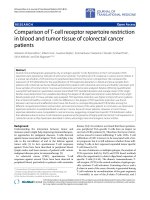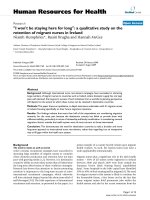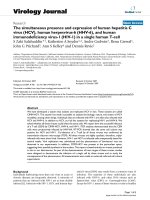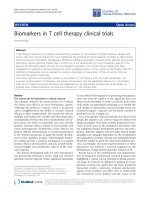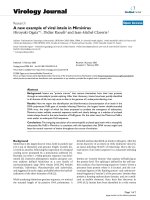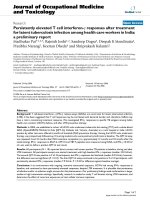Báo cáo sinh học: "Identifying new T -cell regulators?" potx
Bạn đang xem bản rút gọn của tài liệu. Xem và tải ngay bản đầy đủ của tài liệu tại đây (63.07 KB, 4 trang )
Signaling by the T-cell receptor (TCR)
is a well-trodden cellular pathway, and
many of the proteins involved have
been identified and their function
determined in the past two decades.
But therapeutic drugs that target these
signaling molecules and alter the
response of T cells to activation by anti-
gens remain scarce. Uncovering novel
proteins on the signaling pathway
downstream of activation of the TCR
would therefore not only help us to
understand immune responses better
but also aid in the development of
new, more effective drugs to treat
autoimmune diseases such as lupus
and rheumatoid arthritis.
But unraveling this complex
pathway and identifying all the players
is a long and painstaking task. In this
issue of Journal of Biology [1], Peter
Chu, Jorge Pardo, Donald Payan,
Charlene Liao and colleagues describe
a large-scale functional genetic screen
that is in theory capable of picking up
most, if not all, of the molecules of the
TCR signaling pathway. Their work
will benefit researchers in immunology
and other fields who are eager to iden-
tify all the players in a particular sig-
naling pathway (see ‘The bottom line’
box for a summary of the work).
Building on the past
The bulk of known TCR signaling pro-
teins (see the ‘Background’ box) have
been uncovered by classical genetic
and biochemical methods, such as
immunoprecipitation and chemically
induced DNA mutagenesis. For the TCR
and other cellular signaling pathways,
“this is how the chains got built,” says
Donald Payan of Rigel Pharmaceuticals
Research news
Identifying new T-cell regulators
Diane Martindale
BioMed Central
Journal
of Biology
Functional genomic screening for new components of the signaling pathway that is triggered
when T cells are activated has identified novel signaling molecules that are potential drug
targets.
Published: 22 September 2003
Journal of Biology 2003, 2:17
The electronic version of this article is the
complete one and can be found online at
/>© 2003 BioMed Central Ltd
Journal of Biology 2003, 2:17
The bottom line
• A genome-wide functional screening protocol has been developed that
has the potential to identify all the signaling molecules involved in the
pathway downstream of the T-cell receptor, looking for new drug
targets.
• A retroviral fragmented cDNA library, made from lymphocyte mRNA,
allowed the isolation and recovery of sequences encoding dominant
effectors of TCR signaling, as measured by failure of cells to upregulate
the cell-surface marker CD69 in response to an activation trigger.
• Many of the 40 or so proteins identified in the screen were already
known to play roles in TCR signaling, while several others were
known proteins but had not been reported to have a role in TCR
signaling. More than a dozen novel proteins were found; some were
studied further, to validate their function in a physiological setting.
• Although only one specific protein was identified as a potential novel
T-cell drug target, the technique provides a highly efficient strategy to
map entire signaling pathways and is applicable to a wide spectrum of
cell types.
in South San Francisco, where the work
was carried out. “It’s a time-honored
and extremely successful method.”
In the mid-1990s, researchers turned
to retrovirus-based gene transfer as a
way to introduce genes into mam-
malian cells [2]. This powerful technol-
ogy contributed to the cloning of T-cell
antigens, tumor antigens, various
receptors, signaling molecules and tran-
scription factors (reviewed in [2]). In
many of the cases, however, retroviral
cDNA libraries were used for simple
expression cloning, rather than for func-
tional cloning, omitting the element of
functional screening from the assay.
And until now, no one had attempted
to use this type of genetic screening tool
to functionally map out an entire signal-
ing pathway, from cell membrane to
nucleus and everything in between.
Large-scale screening
The large-scale functional screening
approach developed by Chu et al. [1]
used a library of retroviral fragmented
cDNAs from lymphoid tissues to
isolate sequences encoding dominant
effectors - fragmented proteins that
disrupt the TCR signaling pathway.
Expression of some of the sequences
inserted in the library had dominant
effects over their endogenous counter-
parts, either by competitively inhibiting
the endogenous protein or by being
constitutively active. Ultimately, the
researchers hoped that this global func-
tional screen would identify new T-cell
drug targets.
The first step was to make the
cDNA library. To do this, the
researchers extracted mRNA from lym-
phoid organs: the thymus, bone
marrow, lymph nodes and spleen.
Random primers were used to generate a
huge cDNA library containing gene frag-
ments of various sizes that were each
individually packaged into the Moloney
murine leukemia (retro)virus. One of
the keys to this large dominant-effector
genetic screen, explains Charlene
Liao, now at Genentech in South San
Francisco and senior author of the
Journal of Biology article, was to use a
randomly primed cDNA library since
this increases the chance of expressing
truncated proteins with potential dom-
inant-negative or constitutively active
functions.
Millions of Jurkat cells were
infected with the retrovirus library and
activated with an anti-TCR antibody
that mimics what occurs when T cells
are activated by a natural ligand. To
find and recover those rare cells carrying
a cDNA insert affecting TCR signaling,
the authors chose to screen for the
expression of CD69, a cell-surface
marker that is associated with T-cell
activation. The rationale was to identify
cell clones whose CD69 upregulation
(a sign of T-cell activation) in response
to anti-TCR antibody was repressed
following introduction of a sequence
from the retroviral cDNA library. Library
inserts conferring such repression would
then represent immune modulators that
function to block TCR signal transduc-
tion, and thus, proteins that are part of
the normal TCR signaling pathway.
Activated cells were fluorescently
labeled with an anti-CD69 marker and
those with low CD69 expression
selected by fluorescence-activated cell
sorting (FACS). After four rounds of
reiterative sorting, the group ended up
with nearly 3,000 clones of potential
interest. To be certain that the pheno-
type of these clones was due to the
expression of the cDNA library rather
than to epigenetic changes or inser-
tional mutations, each of the selected
clones was further screened to ensure
that the phenotype occurred only
when expression of the insert was
induced (by a derivative of the drug
tetracycline). Nearly half of the origi-
nal clones were selected in this way
for further analysis. The cDNA insert
from each of these clones was recov-
ered and its sequence determined.
When the sequencing was done, the
group had uncovered nearly 40 different
17.2 Journal of Biology 2003, Volume 2, Issue 3, Article 17 Martindale />Journal of Biology 2003, 2:17
Background
• Signaling by the T-cell receptor (TCR) is triggered when the
TCR recognizes antigens (usually from foreign proteins) presented by
the major histocompatibility (MHC) proteins of antigen-
presenting cells. When the TCR is activated, it triggers signaling
through a pathway from the cell surface through to transcription
factors in the nucleus.
• Dominant effectors are mutated or truncated gene sequences that
encode a truncated version of the protein of interest that has the
ability to block the function of its wild-type counterpart or to
represent an activated form of its wild-type counterpart.
• The human T-cell leukemia line Jurkat can be successfully infected
with retroviruses because it is an immortalized cell and is capable of
cell division. The retroviruses can be used to carry cDNAs from a
library into the Jurkat cells, where they are then expressed.
• Fluorescence-activated cell sorting (FACS) is a way of rapidly
separating cells in a suspension on the basis of their size and/or
fluorescence. It is ideally suited to recovering cells with rare
phenotypic traits from large cell populations.
signaling molecules involved in the
TCR pathway.
Validating new components
“At the end of the day, you have a list
of genes that all play a role in T-cell
activation,” says Payan. “The beauty of
this approach is that instead of having
to sift through the entire genome,
you’re sifting through the genome in a
functional way. It allows you to link a
protein with a very specific cellular
activity. This is one of the hardest
things facing scientists right now in the
post-genome era. We’ve got all these
genes, now what do we do? How do
we assign function?”
As expected, many of the proteins in
the list were already known to be TCR
regulators, such as the protein kinases
Lck, ZAP70, Syk and PLC␥1. “What’s
interesting is that the ones we identi-
fied were new truncation mutants,”
says Liao. “Now, we can tell other
researchers who have been working in
the field for 10 years how to make new
dominant-negative mutants or consti-
tutively active mutants of their favorite
proteins.”
In addition, several other genes,
whose sequences had been reported
previously but whose involvement in
TCR signaling was not documented,
were also found in the screen. These
included the G-protein-coupled recep-
tor EDG1, which is involved in
endothelial cell differentiation; PAK2,
a serine/threonine kinase involved in
cytoskeletal reorganization and nuclear
signaling; and the adaptor molecule
Grb7, which mediates the coupling of
various cell-surface receptors to down-
stream signaling pathways. In addi-
tion, the authors report more than a
dozen novel molecules, including one
that they named TRAC-1.
Chu et al. [1] also confirmed the
presence of the transcripts encoding
these proteins in lymphoid organs
using northern blots. Further testing of
lymphocyte subsets with semi-quanti-
tative PCR revealed that these same
genes were also expressed specifically
in T and B cells, as well as in peripheral
blood mononuclear cells. In a final test
to validate the approach, Chu et al.
also showed that these genes are
indeed relevant to the functioning of
primary T lymphocytes.
“This is a Herculean effort: we had
millions of cells, thousands of clones,
and hundreds of sequences,” says
Payan. “Many of the proteins we found
turned out to be known players in T-
cell activation but this validated our
system. I just wish we’d had this tech-
nique in the early ’80s - we could have
dominated the whole [T-cell] field.”
Notably, Payan’s group unraveled
most, if not all, of the TCR signaling
proteins they found in a mere 18
months - a task that has taken others,
using standard mapping methods, 15
Journal of Biology 2003, Volume 2, Issue 3, Article 17 Martindale 17.3
Journal of Biology 2003, 2:17
Behind the scenes
Journal of Biology asked Donald Payan and Charlene Liao about how and
why the group decided on a large functional-genomic screen for T-cell
signaling molecules.
What motivated you to develop this large-scale genetic
screening method and to test it in T cells?
The motivation for the screen was to see if we could find novel proteins
that might be good drug-target candidates for immune regulation and
transplant rejection. This effort did in fact result in several new potential
drug targets being identified.
How long did it take your group to do the experiments and
what were the steps that ensured success?
This was a multidisciplinary effort combining the expertise of our virology,
immunology, high-throughput and molecular biology groups. From start to
finish it took about a year and a half to construct the cell lines, make the
libraries, do the genetic screens, reconfirm all the hits, and do follow-on
confirmatory immunology experiments. As in most large-scale biology
experimentation, good teamwork and the patient development of
bulletproof reagents and sensitive, reproducible assays is what ensured
success.
What was your initial reaction to the results and how were they
received by others?
The responses to the data were very positive, in that we got many known
targets that were previously identified as playing a role in the pathway we
had targeted. The fact that we found novel targets, despite working in a
pathway that had been extensively mined by others, reconfirmed everyone’s
belief that functional genomics is a very powerful tool for finding new drug
targets. Our approach has yielded many new potential drug targets across
numerous pathways that are critical to disease processes.
What are the next steps?
The next step with this technique is to apply it to novel therapeutic areas,
and in addition to take the targets we have identified and do further
biological validation so we can select which ones will be taken forward
into drug screening.
or more years (see the ‘Behind the
scenes’ box for more of the motivation
behind the work).
Not only is this functional genomic
technique highly efficient and fast, it is
also applicable to a broad spectrum of
cells. “Part of the importance and
benefit of this work is that it could be
performed on a wide range of cell types,
for a wide range of functionally impor-
tant readouts. As long as the readout
can be detected in a rare-event detection
screen, the mutants could be identified,
amplified, and checked against the
genome,” says Mark Boothby at Vander-
bilt University Medical School in
Nashville. For example, it could be used
to screen for altered signaling in key
target cells after insulin treatment, to
find novel genes involved in insulin
responsiveness as seen in type II dia-
betes, as well as in neural cells to screen
for mutations affecting ion channels, or
handling of serotonin or dopaminergic
signaling, which occurs in depression
and schizophrenia.
“Another great virtue of the
approach is that you make no assump-
tions as to what the target will be,”
says Philippa Marrack of the Howard
Hughes Medical Institute at the
National Jewish Medical and Research
Center in Denver. Thus, the search is
not biased towards previously known
signaling molecules.
But before drugs can be churned
out, there’s a lot more work to be
done. “What the technique doesn’t tell
you is who’s dancing with whom, and
which is the more dominant partner,
or whether the protein is just part of
this T-cell pathway or shared with
other pathways, and which molecule
comes first, second, third in the chain,”
admits Payan. “As elegant as this
experiment is, it’s only a starting
point.” Before the group can design
inhibitory drugs, they will also need to
determine which part of each protein
is linked to its activity.
Another drawback, notes Boothby,
is that the approach operates on a scale
at which cell lines need to be used, and
like most cell lines, the Jurkat T cells
have pre-existing signaling abnormali-
ties. “Still, this is nice work. It is esti-
mated that we may face the task of
finding new functions for as much as
40 percent of the predicted open
reading frames in the genome. It will
take many different approaches, but
this method is one that will help accel-
erate the process of screening for
promising prospects among the
12,000-plus novel genes that may be
out there in the human and mouse
genomes alone.”
Although the current report does not
pinpoint which novel molecules were
found to be suitable drug targets, the
TRAC-1 protein, which is homologous
to the ubiquitin ligases and has
immune-specific expression, is an inter-
esting candidate. Payan assures us that
the company is now focusing its efforts
on further characterizing a few of the
newly identified molecules. The major-
ity of the proteins found were in the
cytoplasm, and that poses another chal-
lenge because it is enormously difficult
to design drugs that are “cell-permeable
with reasonable pharmacokinetics and
specific for their targets,” notes Marrack.
While the new technique described
by Liao, Payan and colleagues might
not lead immediately to the next
wonder-drug, it has already contributed
to T-cell biology by adding several
potential players - which had not been
picked up by other mapping tech-
niques - to the list of TCR signaling
molecules. And, in turn, these might be
useful in learning how to manipulate
the immune system better and perhaps
to overcome afflictions such as cancer,
infection and autoimmune diseases.
References
1. Chu P, Pardo J, Zhao H, Li C, Pali E, Shen
M, Qu K, Yu S, Huang B, Yu P, et al.: Sys-
tematic identification of regulatory
proteins critical for T-cell activa-
tion. J Biol 2003, 2:21.
2. Lorens B, Sousa C, Bennett M, Molineaux
S, Payan D: The use of retroviruses as
pharmaceutical tools for target dis-
covery and validation in the field of
functional genomics. Curr Opin Biotech-
nol 2001, 12:613-621.
Diane Martindale is a science writer based in
Toronto, Canada.
E-mail:
17.4 Journal of Biology 2003, Volume 2, Issue 3, Article 17 Martindale />Journal of Biology 2003, 2:17

